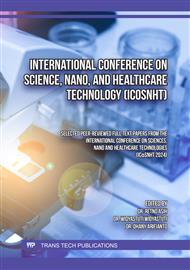[1]
A. Sunjaya, Potensi, Aplikasi dan Perkembangan Digital Health di Indonesia. 2019.
Google Scholar
[2]
A. Prasasti, "Perancangan Filter Analog Multistep pada Photoplethysmograph untuk Mengamati Detak Jantung Manusia Menggunakan Arduino," Jurnal SIFO Mikroskil, vol. 17, Aug. 2016.
DOI: 10.55601/jsm.v17i2.375
Google Scholar
[3]
H.-Y. Lee and T. Burkard, "The Advent of Cuffless Mobile Device Blood Pressure Measurement: Remaining Challenges and Pitfalls," Korean Circ J, vol. 52, Mar. 2022.
DOI: 10.4070/kcj.2021.0405
Google Scholar
[4]
R. Buechi et al., "Evidence assessing the diagnostic performance of medical smartphone apps: a systematic review and exploratory meta-analysis," BMJ Open, vol. 7, no. 12, 2017.
DOI: 10.1136/bmjopen-2017-018280
Google Scholar
[5]
C. R. Nugroho, E. Yuniarti, and A. Hartono, "Alat Pengukur Saturasi Oksigen Dalam Darah Menggunakan Metode Photoplethysmograph Reflectance," Al-Fiziya: Journal of Materials Science, Geophysics, Instrumentation and Theoretical Physics, vol. 3, no. 2, p.84–93, Dec. 2020.
DOI: 10.15408/fiziya.v3i2.17721
Google Scholar
[6]
C. L. Petersen, T. P. Chen, J. M. Ansermino, and G. A. Dumont, "Design and Evaluation of a Low-Cost Smartphone Pulse Oximeter," Sensors, vol. 13, no. 12, p.16882–16893, 2013.
DOI: 10.3390/s131216882
Google Scholar
[7]
T. Coppetti et al., "Accuracy of smartphone apps for heart rate measurement," Eur J Prev Cardiol, vol. 24, p.1287–1293, 2017, [Online]. Available: https://api.semanticscholar.org/CorpusID:4722168
Google Scholar
[8]
C. Raichle et al., "Performance of a Blood Pressure Smartphone App in Pregnant Women: The iPARR Trial (iPhone App Compared With Standard RR Measurement)," Hypertension, vol. 71, p. Hypertensionaha.117.10647, Apr. 2018.
DOI: 10.1161/Hypertensionaha.117.10647
Google Scholar
[9]
W. Pipitprapat, S. Harnchoowong, P. Suchonwanit, and C. Sriphrapradang, "The validation of smartphone applications for heart rate measurement," Ann Med, vol. 50, no. 8, p.721–727, Nov. 2018.
DOI: 10.1080/07853890.2018.1531144
Google Scholar
[10]
A. S. Vischer et al., "Comparability of a Blood-Pressure-Monitoring Smartphone Application with Conventional Measurements—A Pilot Study," Diagnostics, vol. 12, no. 3, 2022.
DOI: 10.3390/diagnostics12030749
Google Scholar
[11]
T. B. Plante et al., "Validation of the Instant Blood Pressure Smartphone App," JAMA Intern Med, vol. 176, no. 5, p.700–702, May 2016.
DOI: 10.1001/jamainternmed.2016.0157
Google Scholar
[12]
E. D. Chan, M. M. Chan, and M. M. Chan, "Pulse oximetry: Understanding its basic principles facilitates appreciation of its limitations," Respir Med, vol. 107, no. 6, p.789–799, 2013.
DOI: 10.1016/j.rmed.2013.02.004
Google Scholar
[13]
E. Jo, K. Lewis, D. Directo, M. J. Y. Kim, and B. Dolezal, "Validation of Biofeedback Wearables for Photoplethysmographic Heart Rate Tracking," J Sports Sci Med, vol. 15, p.540–547, Sep. 2016.
Google Scholar
[14]
C. Scully et al., "Physiological Parameter Monitoring from Optical Recordings With a Mobile Phone," IEEE Trans Biomed Eng, vol. 59, p.303–306, Jul. 2011.
DOI: 10.1109/TBME.2011.2163157
Google Scholar
[15]
J. Allen, "Photoplethysmography and its application in clinical physiological measurement," Physiol Meas, vol. 28, pp. R1-39, Apr. 2007.
DOI: 10.1088/0967-3334/28/3/R01
Google Scholar
[16]
B. Boudreaux et al., "Validity of Wearable Activity Monitors during Cycling and Resistance Exercise," Med Sci Sports Exerc, vol. 50, p.1, Mar. 2018.
DOI: 10.1249/MSS.0000000000001471
Google Scholar
[17]
C. Shi et al., "The accuracy of pulse oximetry in measuring oxygen saturation by levels of skin pigmentation: a systematic review and meta-analysis," BMC Med, vol. 20, Aug. 2022.
DOI: 10.1186/s12916-022-02452-8
Google Scholar
[18]
A. S. Rajawat, O. Mohammed, R. N. Shaw, and A. Ghosh, "Chapter six - Renewable energy system for industrial internet of things model using fusion-AI," in Applications of AI and IOT in Renewable Energy, R. N. Shaw, A. Ghosh, S. Mekhilef, and V. E. Balas, Eds., Academic Press, 2022, p.107–128.
DOI: 10.1016/B978-0-323-91699-8.00006-1
Google Scholar
[19]
H. Mustafidah and S. N. Rohman, "Mean Square Error pada Metode Random dan Nguyen Widrow dalam Jaringan Syaraf Tiruan Mean Square Error on Random and Nguyen Widrow Method on Artificial Neural Networks".
DOI: 10.30595/sainteks.v19i1.12931
Google Scholar
[20]
S. Robeson and C. Willmott, "Decomposition of the mean absolute error (MAE) into systematic and unsystematic components," PLoS One, vol. 18, p. e0279774, Feb. 2023.
DOI: 10.1371/journal.pone.0279774
Google Scholar
[21]
P. Schober, C. Boer, and L. Schwarte, "Correlation Coefficients: Appropriate Use and Interpretation," Anesth Analg, vol. 126, p.1, Feb. 2018.
DOI: 10.1213/ANE.0000000000002864
Google Scholar


